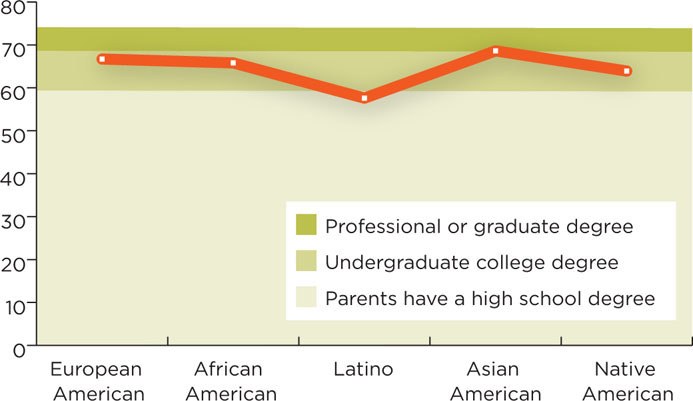9.3 Early-Childhood Education
A hundred years ago, children had no formal education until first grade, which, as mentioned earlier, is why it was called “first” and why young children were “preschoolers.” Today, virtually every nation provides some early-childhood education, sometimes financed by the government, sometimes privately (Britto et al., 2011). In some countries, most 3- to 6-year-olds are in school (see Figure 9.5 for U.S. trends), not only because of changing family and economic patterns but also because research has verified that young children can accomplish a great deal of cognitive advance and language learning.
Observation Quiz At what point did the percentage of 3- to 4-year-olds in school exceed that of 18- to 19-year-olds in college?
Answer to Observation Quiz: Between 1985 and 1990. The exact year (not shown) was 1988.
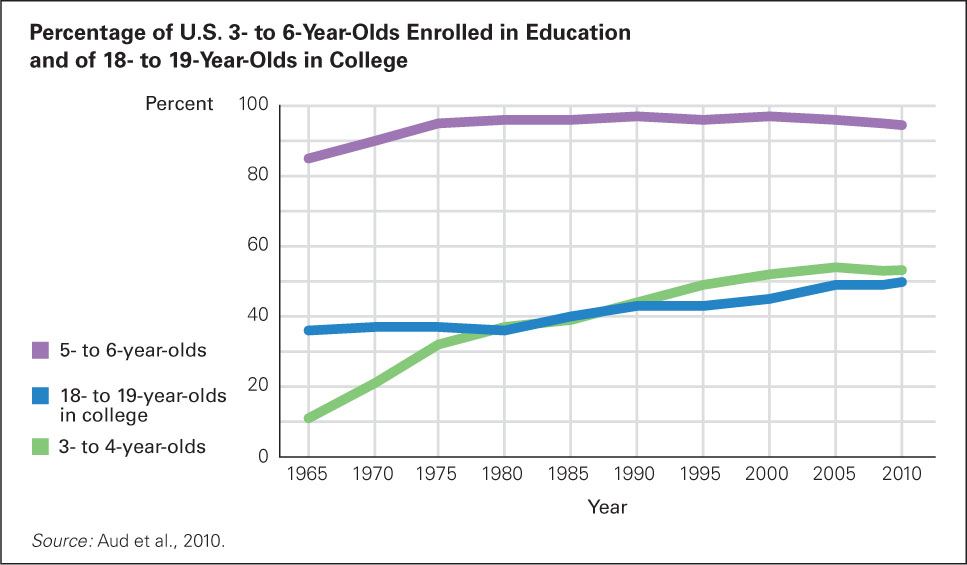
Changing Times Because research increasingly finds that preschool education provides a foundation for later learning, most young children are enrolled in educational programs. Note the contrast with the proportion of 18- to 19-year-olds in college (not shown are the 18- to 19-year-olds still in high school—about 15 percent).
Homes and Schools
One robust research conclusion about children’s learning is that the quality of the learning context matters. If home education is poor, a good preschool program aids health, cognition, and social skills (Hindman et al., 2010). However, if a family provides extensive learning opportunities and encouragement, the quality of the preschool is less crucial. It is better for the young children to be at such a home than in a stressful, overcrowded preschool.
It is difficult to judge the quality of homes and schools in the United States because of the “stunning variability and fragmentation” of public and private schools (Pianta et al., 2009, p. 50) and the changing configuration of home care. It is a mistake to conclude that care by the mother is better than care by another relative or nonrelative—or vice versa. Mother care varies: Some mothers are fabulous, others disastrous.
Group care also varies, both in name and practice. Educational institutions for young children are called preschools, nursery schools, day-care centers, pre-primary programs, pre-K classes. Sometimes the sponsoring agencies are noted: public, private, church, corporation. None of these labels reliably indicates quality (A. S. Fuligni et al., 2009). Each early-childhood program (and sometimes each teacher) emphasizes different skills, goals, and methods.
Early-childhood education can be considered to be child-centered or teacher-directed. Remember, however, that the quality of the home and the effectiveness of the teachers have greater impact on young children than does the label or professed philosophy. Also remember that young children are shaped by their culture and differentiated by their genes, so a child who flourishes in one setting might languish in another, and some contexts work only for certain children. Parents need to find a good fit for their child, their values, and their income—not an easy task.
Child-Centered Programs
Especially for Teachers In trying to find a preschool program, what should parents look for?
Response for Teachers: Tell parents to look at the people more than the program. Parents should see the children in action and note whether the teachers show warmth and respect for each child.
Many programs are called developmental, or child-centered, because they stress each child’s development and growth. Teachers in such programs believe children need to follow their own interests rather than adult directions. For example, they agree that “children should be allowed to select many of their own activities from a variety of learning areas that the teacher has prepared” (Lara-Cinisomo et al., 2011). The physical space and the materials (such as dress-up clothing, art supplies, puzzles, blocks, other toys) are arranged to allow self-paced exploration.
Most child-centered programs encourage artistic expression. Some educators argue that young children “are all poets” in that they are gifted in seeing the world more imaginatively than older people do. According to advocates of child-centered programs, this peak of creative vision should be encouraged; children are given many opportunities to tell stories, draw pictures, dance, and make music for their own delight.
That does not mean that academics are ignored. Advocates of math learning, for instance, believe that children have a natural interest in numbers and that child-centered schools can guide those interests as children grow (Stipek, 2013).
Especially for Unemployed Early-Childhood Teachers You are offered a job in a program that has 10 3-year-olds for every 1 adult. You know that is too many, but you want a job. What should you do?
Response for Unemployed Early-Childhood Teachers: It would be best for you to wait for a job in a program where children learn well, organized along the lines explained in this chapter. You would be happier, as well as learn more, in a workplace that is good for children. Realistically, though, you might feel compelled to take the job. If you do, change the child/adult ratio—find a helper, perhaps a college intern or a volunteer grandmother. But choose carefully—some adults are not helpful at all. Before you take the job, remember that children need continuity: You can’t leave simply because you find something better.

Tricky Indeed Young children are omnivorous learners, picking up habits, curses, and attitudes that adults would rather not transmit. Deciding what to teach—by actions more than words—is essential.
© THE NEW YORKER COLLECTION 1991 ROBERT WEBER FROM CARTOONBANK.COM. ALL RIGHTS RESERVED.
Child-centered programs are often influenced by Piaget, who emphasized that each child will discover new ideas, and by Vygotsky, who thought that children learn from other children, with adult guidance (Bodrova & Leong, 2005). Trained teachers are crucial: A child-centered program requires appropriate activities for each child and teachers who guide and scaffold so that each child advances (Dominguez et al., 2010).
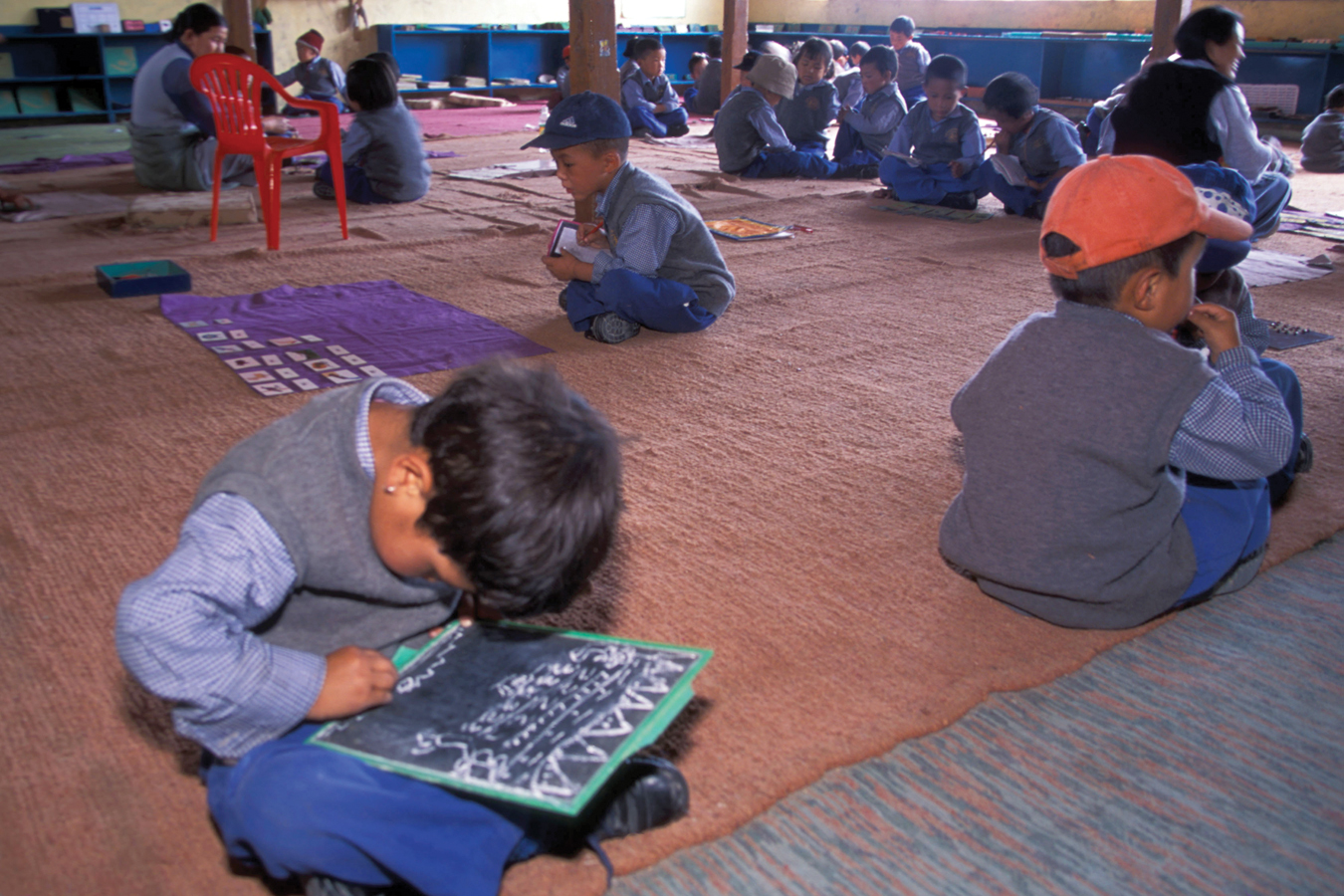
Tibet, China, India, and … Italy? Over the past half-century, as China increased its control of Tibet, thousands of refugees fled to northern India. Tibet traditionally had no preschools, but young children adapt quickly, as in this preschool program in Ladakh, India. This Tibetan boy is working a classic Montessori board.
© INFOCUSPHOTOS.COM/ALAMY
Montessori Schools
One type of child-centered school began more than 100 years ago, when Maria Montessori opened nursery schools for poor children in Rome. She believed that children needed structured, individualized projects to give them a sense of accomplishment. Her students completed puzzles, used sponges and water to clean tables, traced shapes, and so on.
Montessori schools Schools that offer early-childhood education based on the philosophy of Maria Montessori, which emphasizes careful work and tasks that each young child can do.
Contemporary Montessori schools still emphasize individual pride and achievement, presenting many literacy-related tasks (e.g., outlining letters and looking at books) to young children (Lillard, 2005). Specific materials differ from those that Montessori developed, but the underlying philosophy is the same. Children seek out learning tasks; they do not sit quietly in groups while a teacher instructs them. That makes Montessori programs child-centered (Lillard, 2013).
This philosophy seems to work. A study of 5-year-olds in inner-city Milwaukee who were chosen by lottery to attend Montessori programs found that the children were advanced in prereading (such as recognizing letters), math, and theory of mind, compared with their peers in other schools (Lillard & Else-Quest, 2006). Some benefits became more apparent by middle school (called a sleeper effect, because the benefits seem to hibernate for a while) (Lillard, 2013). The probable explanation: Montessori tasks lead to self-confidence, curiosity, and exploration, which eventually motivate learning to read, calculate, and so on.
Reggio Emilia
Reggio Emilia A program of early-childhood education that originated in the town of Reggio Emilia, Italy, and that encourages each child’s creativity in a carefully designed setting.
Another form of early-childhood education is Reggio Emilia, named after the town in Italy where it began. In Reggio Emilia, children are encouraged to master skills that are not usually taught in North American schools until age 7 or so, such as writing and using tools (hammers, knives, and so on).

Child-Centered Pride How could Rachel Koepke, a 3-year-old from a Wisconsin town called Pleasant Prairie, seem so pleased that her hands (and cuffs) are blue? The answer arises from northern Italy—Rachel attended a Reggio Emilia preschool that encourages creative expression.
ELIZABETH FLORES KRT/NEWSCOM
Reggio schools do not provide large-group instruction, with lessons in, say, forming letters or cutting paper. Instead, “Every child is a creative child, full of potential” (Gandini et al., 2005, p. 1), with personal learning needs and artistic drive. Measurement of achievement, such as standardized testing to see whether children have learned their letters, is not part of the core belief that each child should explore and learn in his or her own way (Lewin-Benham, 2008).
Appreciation of the arts is evident. Every Reggio Emilia school has a studio, an artist, and space to encourage creativity. Consequently, Reggio Emilia schools have a large central room with many hubs of activity and a low child/adult ratio. Children’s art is displayed on white walls and hung from high ceilings, and floor-to-ceiling windows open to a spacious, plant-filled playground. Big mirrors are part of the schools’ décor—again, with the idea of fostering individuality and self-expression.
The curious little scientist is encouraged with materials to explore. One analysis of Reggio Emilia in the United States found “a science-rich context that triggered and supported preschoolers’ inquiries and effectively engaged preschoolers’ hands, heads, and hearts with science” (Inan et al., 2010, p. 1186).
Teacher-Directed Programs
Teacher-directed preschools stress academics, often taught by one adult to the entire group. The curriculum includes learning the names of letters, numbers, shapes, and colors according to a set timetable; every child naps, snacks, and goes to the bathroom on schedule as well. Children learn to sit quietly and listen to the teacher. Praise and other reinforcements are given for good behavior, and timeouts (brief separation from activities) are imposed to punish misbehavior.
In teacher-directed programs, the serious work of schooling is distinguished from the unstructured play of home. According to a study of preschool educators, some teachers endorse ideas that indicate their teacher-directed philosophy, such as that children should form letters correctly before they are allowed to write a story (Lara-Cinisomo et al., 2011).
The goal of teacher-directed programs is to make all children “ready to learn” when they enter elementary school. For that reason, basic skills are stressed, including precursors to reading, writing, and arithmetic, perhaps through teachers asking questions that children answer together in unison.
Children practice forming letters, sounding out words, counting objects, and writing their names. If a 4-year-old learns to read, that is success. (In a child-centered program, that might arouse suspicion that there was too little time to play or socialize.) Good behavior, not informal social interaction, is rewarded—leading one critic to suggest that “readiness” is too narrowly defined (Winter, 2011).
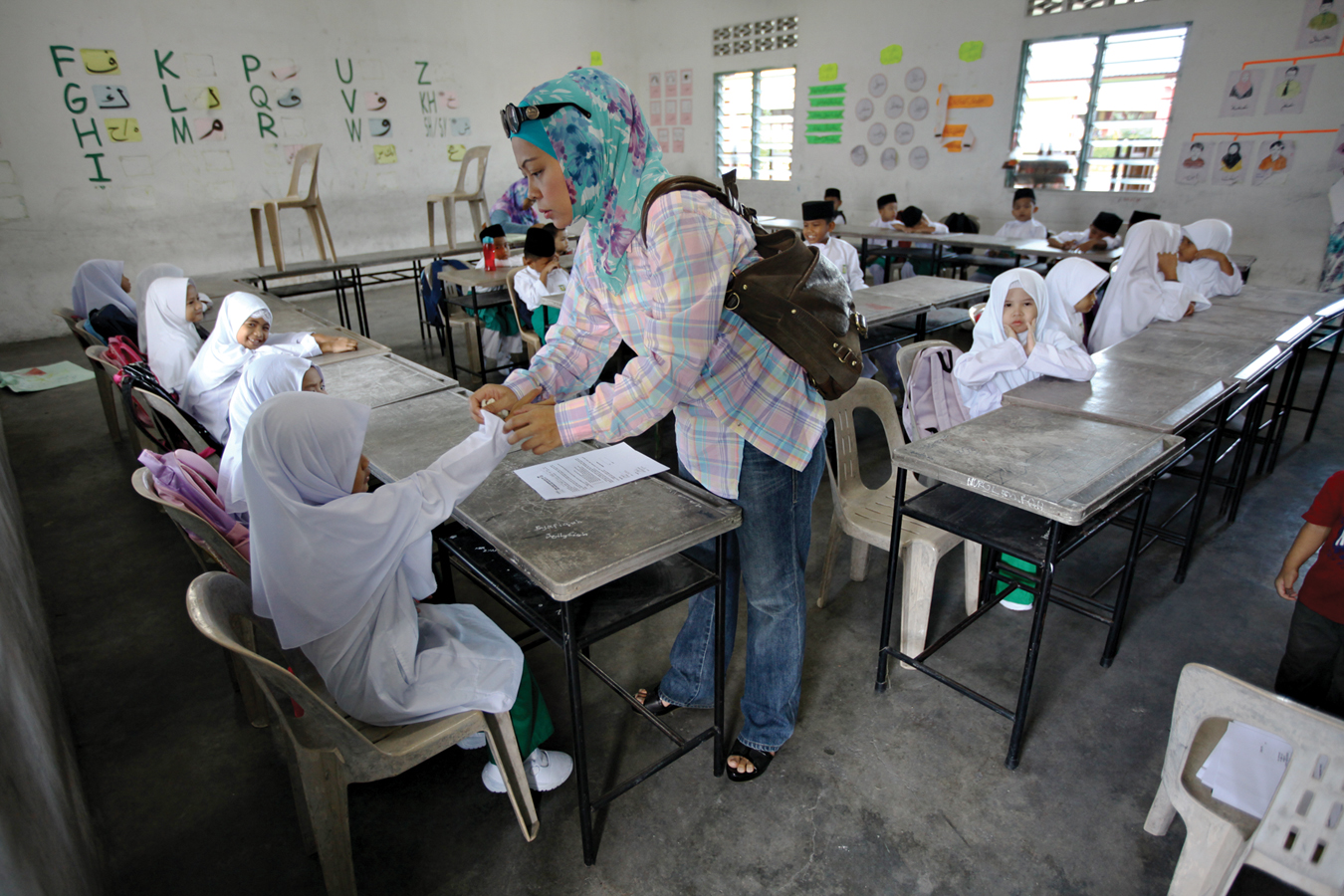
Learning from One Another Every nation creates its own version of early education. In this scene at a nursery school in Kuala Lumpur, Malaysia, note the head coverings, uniforms, and distance between the sexes. None of these elements would be found in most early-childhood-education classrooms in North America or Europe.
MOHD RASFAN/AFP/GETTY IMAGES
Many teacher-directed programs were inspired by behaviorism, which emphasizes step-by-step learning and repetition, with reinforcement (praise, gold stars, prizes) for accomplishment. Another inspiration for teacher-directed programs comes from research indicating that children who have not learned basic vocabulary and listening skills by kindergarten often fall behind in primary school. Many state legislatures mandate that preschoolers learn particular concepts, an outcome best achieved by teacher-directed learning (Bracken & Crawford, 2010).
Most developmentalists and most teachers advocate child-centered programs. But studies show that teachers’ classroom behaviors do not always correlate with their beliefs (Tonyan et al., 2013). In fact, most teachers lead more than follow the children’s lead (see Figure 9.6). This was true even among teachers who said they took a child-centered approach—especially if they were novice teachers. For instance, they might say they are child-centered but tell children what to do instead of asking them their ideas). Teachers with more experience or training were more likely to be consistent in belief and behavior (Wen et al., 2011).
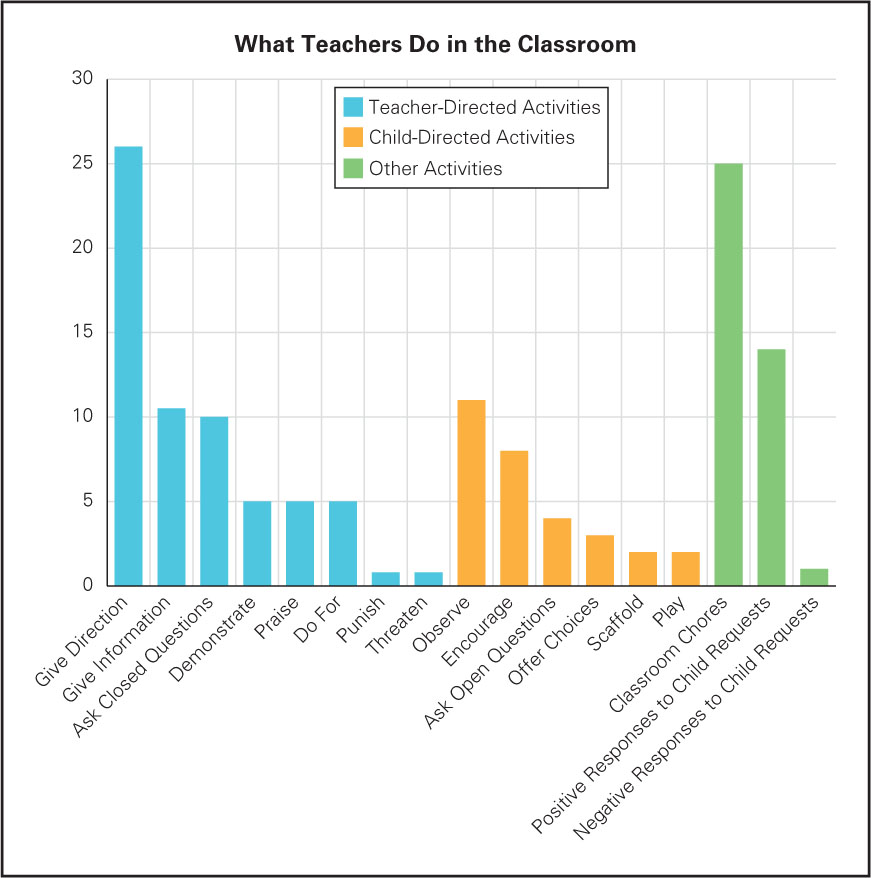
Don’t Blame the Teacher Children develop their own ideas best when adults listen, encourage, and play, but most adults give directions, provide information, and ask questions they know the answer to. This is true for parents, strangers, and as shown here, even teachers who try to be child-centered.
Source: Wen, Elicker, and McMullen (2011).
Head Start
Head Start A federally funded early-childhood intervention program for low-income children of preschool age.
In the early 1960s, millions of young children in the United States were thought to need a “head start” on their formal education to help foster better health and cognition before first grade. Early education was considered to be a necessary intervention for poor children of all ethnicities. Consequently, since 1965 the federal government has funded a massive program for 4-year-olds called Head Start.
The goals for Head Start have changed over the decades, from lifting families out of poverty to promoting literacy, from providing dental care and immunizations to teaching Standard English. Although initially most Head Start programs were child-centered, they have become increasingly teacher-directed as waves of legislators have approved and shaped them. Children have learned whatever their Head Start teachers and curricula emphasize.
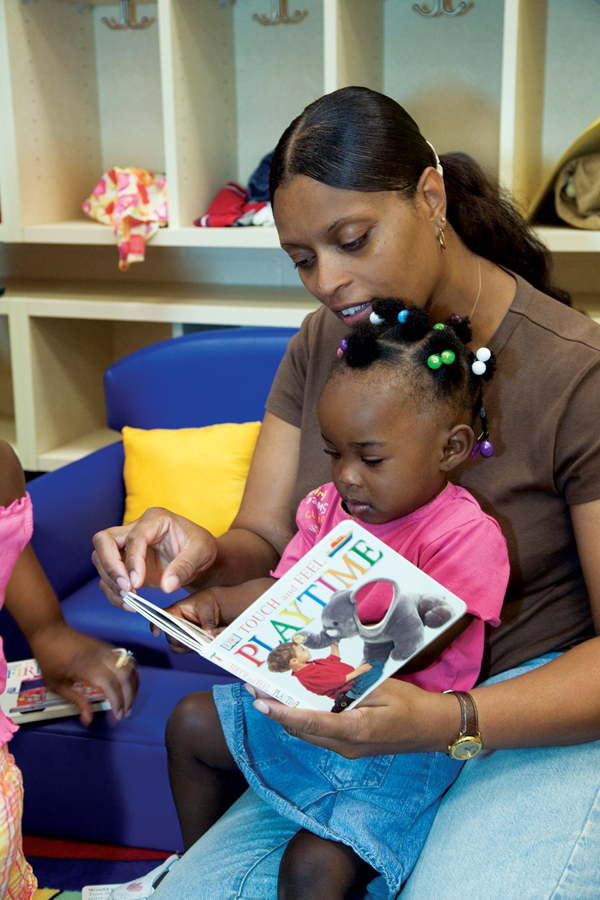
Disaster Recovery The success of Head Start led to Early Head Start for children such as this 2-year-old in Biloxi, Mississippi. When Hurricane Katrina destroyed most of the community, it was the first educational program to reopen. Since a family is a system, not just a collection of individuals, this Head Start program is helping parents as well as entire families recover.
© JIM WEST/ALAMY
For example, many low-income 3- and 4-year-olds in the United States are not normally exposed to math. After one Head Start program engaged children in a board game with numbers, their mathematical understanding advanced significantly (Siegler, 2009). A congressional reauthorization of funding for Head Start included a requirement for extensive evaluation to answer two questions:
- What difference does Head Start make to key outcomes of development and learning (in particular, school readiness) for low-income children? How does Head Start affect parental practices?
- Under what circumstances and for whom does Head Start achieve the greatest impact?
The answers were not as dramatic as either advocates or detractors had hoped (U.S. Department of Health and Human Services, 2010). Head Start improved literacy and math skills, oral health, and parental responsiveness. However, many academic benefits faded by first grade. One explanation is that, unlike when Head Start began, many children in the comparison group were enrolled in other early-childhood programs—sometimes excellent ones, sometimes not.
The research found that benefits were strongest for children with the lowest family incomes, for those living in rural areas, and for those with disabilities (U.S. Department of Health and Human Services, 2010). These children are least likely to find other sources of early education. Most Head Start children advanced in language and social skills, but by elementary school the comparison children often caught up, with one exception: Head Start children were still ahead in vocabulary.
That finding also supports what you have just read about early childhood as a sensitive period for language learning. Any good preschool will introduce children to words they would not learn at home. Children will fast-map those words, gaining a linguistic knowledge base that facilitates expanded vocabulary throughout life.
The Need for Structure
Many developmentalists resist legislative prescriptions (such as those in some current Head Start regulations) regarding what 3- and 4-year-olds should learn. Some teachers want to do whatever they believe is best, resulting in a happy hodgepodge of strategies and rules. However, this approach may confuse children and parents. Differences may reflect culture, not what theory and research suggest is best.
For example, in a detailed study in the Netherlands, native-born Dutch teachers emphasized individual achievement (child-centered) more than did the teachers from the Caribbean or Mediterranean, who stressed proper behavior and group learning (teacher-directed) (Huijbregts et al., 2009). Teachers of either background who had worked together for years shared more beliefs and practices than new teachers did (Huijbregts et al., 2009). Hopefully, they had learned from one another.
Similar discrepancies were found in a study of U.S. preschool teachers. Those who were younger and had more education often differed from those who were older and had more experience—yet both groups thought their way was best (Tonyan et al., 2013).
As many studies have shown, children can learn whatever academic and social skills are taught to them; those who attend preschool advance in cognitive skills because such skills are emphasized (Camilli et al., 2010; Chambers et al., 2010). But no matter what the curriculum, all young children need personal attention, consistency, and continuity: It does not help when every adult applies idiosyncratic rules and routines.
For this reason, among many others, parents and teachers should communicate and cooperate with each other in teaching young children, a strategy Head Start has emphasized from the early days. It also is true that a warm teacher–child relationship fosters learning no matter what kind of curriculum or strategy is used (Howes et al., 2013).
Bilingual Education
Dual Language Learners (DDLs) Children who develop skills in two languages are dual language learners. Ideally education fosters proficiency in two languages rather than creating a language shift.
The need for a coherent strategy is apparent in bilingual education. Successful strategies need to vary depending on the child, the home background, and national values. As one review concludes, “It is highly unlikely that one approach will be equally effective for all DLLs (dual language learners)” (Hammer et al., 2011), but some strategy is needed.
U.S. research has focused on young children of Hispanic heritage. In general, programs that combine English and Spanish instruction, sometimes with half a day for each, are more successful at teaching English while advancing Spanish than are programs that simply immerse the Spanish-speaking children in an English-only setting (Barnett et al., 2007) or keep Spanish as the sole language of instruction.
Unfortunately, for political, cultural, and economic reasons, Hispanic American children are among the young children who are least likely to attend preschool in the United States (see Figure 9.7). After decades of steady gains in preschool education, enrollment of Hispanic American children decreased in the United States during the economic recession, which coincided with increased rates of deportation of the 11 million undocumented immigrants (Fuller & Kim, 2011). This is especially troubling for children from Spanish-speaking homes: As discussed earlier, learning a second language is easiest before age 4.
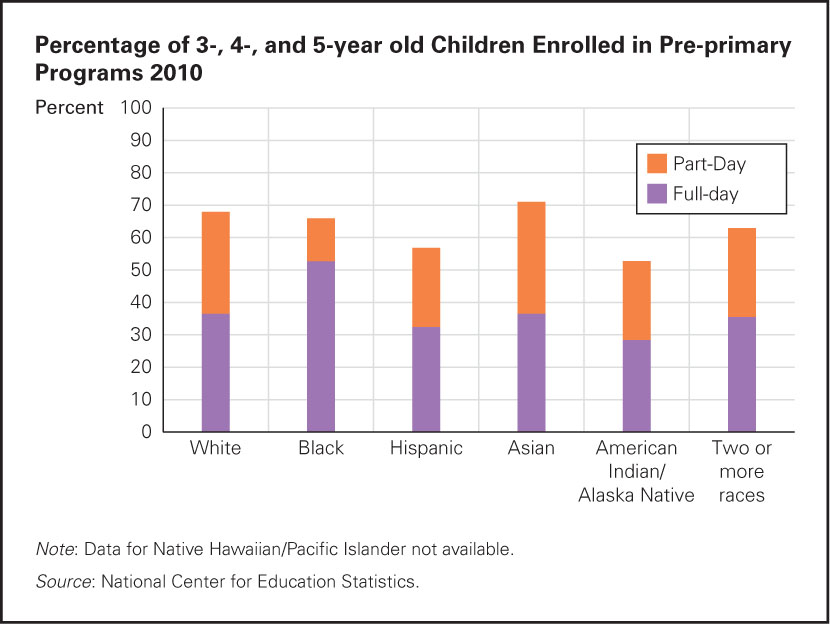
Early Advantage Since even the critics agree that early education advances language and literacy, it is troubling that the children who most need language learning are least likely to be in pre-primary programs of any kind - public, private, or church related.
Head Start now requires that all children in the program be from low-income families. Many Hispanic children qualify and hence could take advantage of free early education. However, even in Head Start, Hispanic children are less likely to be enrolled than other low-income children.
One reason for the low attendance of young Spanish-speaking children (most of whom are U.S. citizens) is their parents’ fear of deportation if anyone in the extended family is undocumented. Another reason is custom: The evidence that young children benefit from preschool is familiar to most English-speaking adults, but not to most immigrants.
Added problems are that many Head Start programs are limited to three hours a day, few teachers are native Spanish speakers, and the mothers least likely to have jobs are those who speak only Spanish. For all these reasons, many families choose mothers or grandmothers to provide child care until kindergarten, not realizing the impact of Spanish-only care on later education.
The percentage of Hispanics in early education would be even lower if the statistics included noncitizen children. Almost none of them are eligible for public preschool, although all of them can attend public school once they reach age 6. Consequently, each year, almost a million children enter first grade in the United States with poor English skills, often because they had no early education.
Of course, not all immigrant children have similar needs. Spanish-speaking children whose origins are Puerto Rican, Cuban, or other Latino have experiences that are unlike Mexican-origin children. Further, each local jurisdiction (each state in the U.S. and each nation elsewhere) has distinct policies—some welcoming, some not. Moreover, many ELLs are not Hispanic. Their parents have distinct expectations and attitudes. Home-school communication is crucial for all young children; they learn best when all the adults share strategies and goals.
Long-Term Gains from Intensive Programs
This discussion of philosophies, practices, and programs may give the impression that the research on early childhood cognition is contradictory. That is not true. Specifics are debatable, but empirical evidence and longitudinal evaluation find that preschool education advances learning. Ideally, each program has a curriculum that guides practice, all the adults collaborate, and experienced teachers respond to each child.
The best evidence comes from three longitudinal programs that enrolled children for years, sometimes beginning with home visits in infancy, sometimes continuing in after-school programs through first grade. One program, called Perry (or High/Scope), was spearheaded in Michigan (Schweinhart & Weikart, 1997); another, called Abecedarian, got its start in North Carolina (Campbell et al., 2001); a third, called Child–Parent Centers, began in Chicago (Reynolds, 2000). Because of the political context when these programs began, all were focused on children from low-SES families.
All three programs compared experimental groups of children with matched control groups, and all reached the same conclusion: Early education has substantial long-term benefits that become most apparent when children are in the third grade or later. By age 10, children who had been enrolled in any one of these three programs scored higher on math and reading achievement tests than did other children from the same backgrounds, schools, and neighborhoods. They were less likely to be placed in special classes for slow or disruptive children or to repeat a year of school.
An advantage of longitudinal research over the decades is that teenagers and adults who received early education can be compared with those who did not. For all three programs, early investment paid off. In adolescence, the children who had undergone intensive preschool education had higher aspirations, possessed a greater sense of achievement, and were less likely to have been abused. As young adults, they were more likely to attend college and less likely to go to jail. As middle-aged adults, they were more often employed, paying taxes and not needing government subsidies (Reynolds & Ou, 2011; Schweinhart et al., 2005).
Early education affected every aspect of adult life. One review concluded that “early cognitive and scholastic advantages lead to social and motivational gains that culminate in enhanced well-being” (Reynolds & Ou, 2011, p. 578).
All three research projects found that providing direct cognitive training (rather than simply letting children play), with specific instruction in various school-readiness skills, was useful. Each child’s needs and talents were considered—a circumstance made possible because the child/adult ratio was low. The curricular approach combined child-centered and teacher-directed programs, with all the teachers trained together, so children were not confused. Teachers involved parents in their children’s education, and each program included strategies to enhance the home–school connection.
These programs were expensive (ranging from $6,000 to $18,000 annually per young child in 2014 dollars). From a developmental perspective, the decreased need for special education and other social services makes early education a “wise investment” (Duncan & Magnusson, 2013, p. 128). The benefits to society over the child’s lifetime, including increased employment, taxes, and reduced crime, are much more than that.
The greatest lifetime return came from boys from high-poverty neighborhoods in the Chicago preschool program: The social benefit over their lifetime was more than 12 times the cost (Reynolds et al., 2011). Unfortunately costs are immediate and benefits are long term. Consequently, some legislators and voters are unwilling to fund expensive intervention programs that do not pay off until decades later.
That is changing. Most states sponsor public education for young children—although usually only for low-income 4-year-olds. In 2009–2010, more than a million children (1,292,310) attended state-sponsored preschools—double the number a decade earlier (Barnett et al., 2010). Since 4 million (actually, 4,268,000) children were born in 2006, that is slightly more than one child in three. Although early education is free in some nations, most U.S. parents pay for it. That is one reason why families in the highest income quartile are more likely to have their 3- and 4-year-old in an educational program (see Visualizing Development, p. 271).
From a developmental perspective, the leading state is Oklahoma, which provides full-day kindergarten and preschool education for all children. Attendance is voluntary, but most children are enrolled. The Oklahoma curriculum emphasizes literacy and math; benefits are particularly strong for children whose home language is Spanish (Phillips et al., 2009).
Although developmentalists are pleased that the public finally recognizes the benefits of early education, the message that quality matters does not seem to be understood. For the 40 states that sponsor early education, the average funding is less than $5,000 per year per student. That is not enough to pay for a low child/adult ratio, teachers with college degrees, and professional mentoring in a safe, well-equipped space.
Note also that the initial research was on low-income children. Most developmentalists think that the findings apply to all children, but that is controversial—especially when funding for education at all levels is diminishing.
The same dilemma is apparent for many aspects of early cognition. Much more is known now than formerly about what children can learn, and there is no doubt that 2- and 3-year-olds are capable of learning languages, concepts, and much else. A hundred years ago, that was not understood. Piaget was a leader in recognizing the abilities of the child. Now Piaget’s work has been eclipsed by new research: What a child learns before age 6 is pivotal for later schooling and adult life, yet many children do not learn what they need to know.
This theme continues in the next chapter, where we talk about the interaction between children and all the systems that surround them.
SUMMING UP
Young children can learn a great deal before kindergarten, in either a child-centered or teacher-directed preschool, or in an excellent home setting. Montessori and Reggio Emilia schools advance children’s learning. Both emphasize individual accomplishments and child development.
Teacher-directed programs stress readiness for school, emphasizing letters and numbers that all children should understand. Head Start and other programs advance learning for low-income children. Longitudinal research finds that some of the benefits are evident in adulthood. However, quality and accessibility are variable. The best programs are expensive; the benefits are apparent only decades later.
VISUALIZING DEVELOPMENT
Early Childhood Education
Preschool can be an academic and social benefit to children. Around the world, increasing numbers of children are enrolled in early childhood education programs.
Early childhood education programs are described as “teacher-directed” or “child-centered,” but in reality, most teachers’s styles reflect a combination of both approaches. Some students benefit more from the order and structure of a teacher-directed classroom, while others work better in a more collaborative and creative environment.

CHARACTERISTICS OF U.S. PRESCHOOLERS Proportion of children who are enrolled in preschool, by ethnicity and parents’ education. You’ll see a larger proportion of children whose parents have a graduate degree go to preschool than those whose parents have only a high school diploma.
PHOTO: WORTH PUBLISHERS
TEACHER-DIRECTED APPROACH
Focused on Getting Preschoolers Ready to Learn
Direct instruction
Teacher as formal authority
Students learn passively
Classroom is orderly and quiet
Teacher fully manages lesssons
Fosters independence
Encourages academics
Students learn from teacher
STUDENT-CENTERED APPROACH
Focused on Individual Development and Growth
Teacher as facilitator
Teacher as delegator
Students learn actively
Classroom is designed for collaborative work
Students direct content
Fosters collaboration
Encourages artistic expression
Students learn from other students
DIFFERENT STUDENTS, DIFFERENT TEACHERS
There is clearly no “one right way” to teach children. Each approach has potential benefits and pitfalls. A classroom full of independent, self-motivated students can thrive when a gifted teacher acts as a competent facilitator. But students who are distracted or annoyed by noise, or who are shy or intimidated by other children, can blossom under an engaging and encouraging teacher in a more traditional environment.
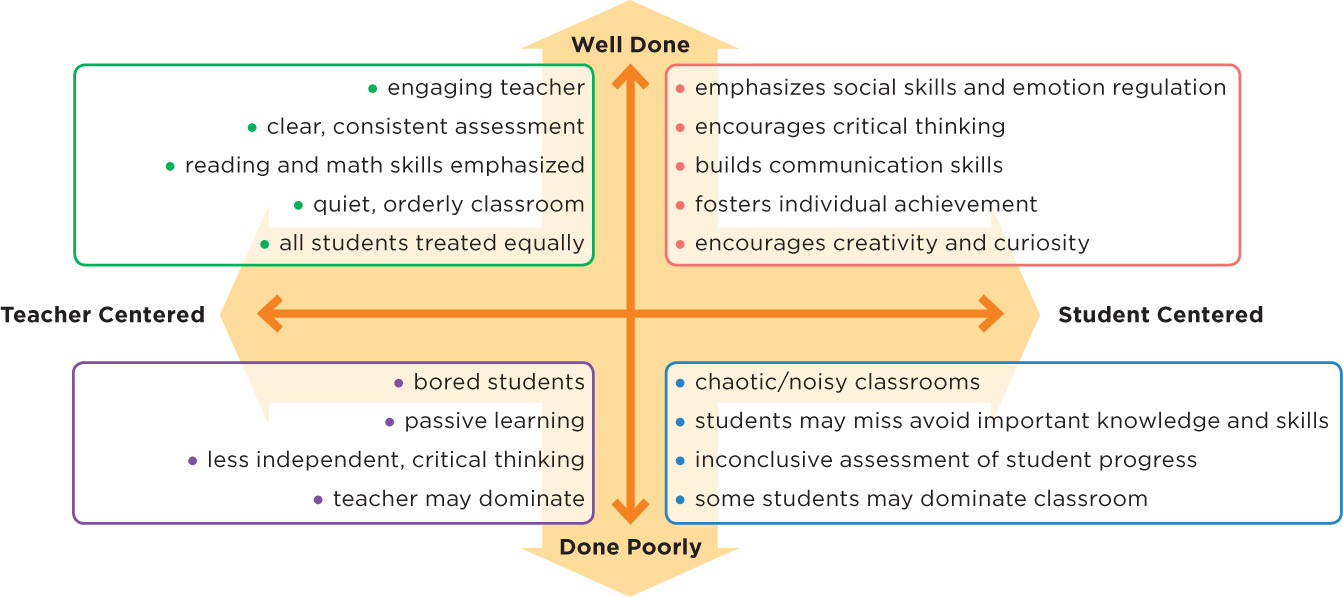
SOURCES & CREDITS LISTED ON P. SC-1









